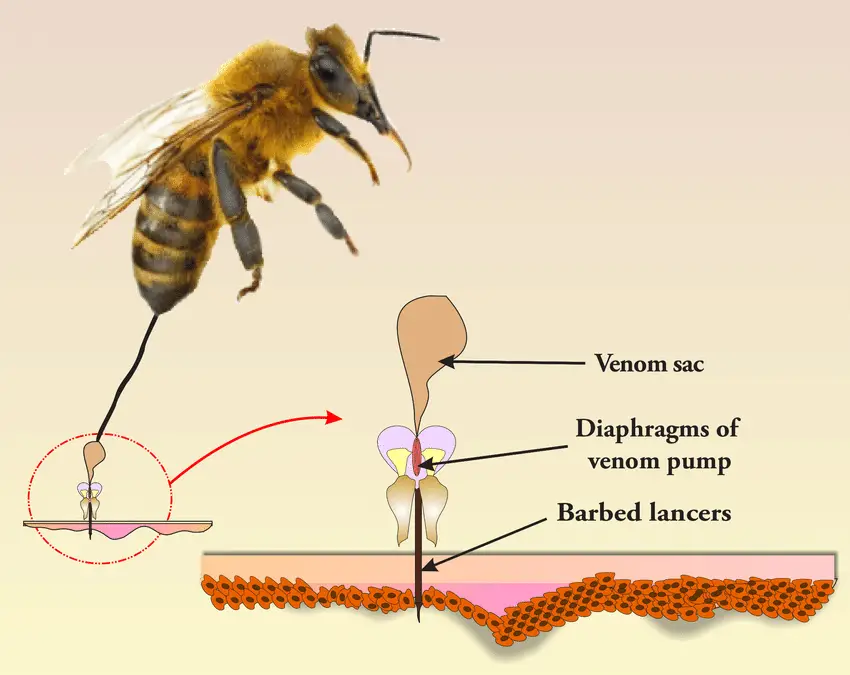I was nearly 11 years old when I remember my family preparing for a picnic and I along with my uncle went into the store to bring firewood. The least could we expect a beehive nicely stationed itself on the piles of logs of wood.
Yes! You guess it right, I was wearing a pair of jeans and still got stung by 7 bees on my thigh!
So, the moral of the story?
A bee can definitely sting through jeans!
But let’s find out how and why…..
The difference between the length of a stinger and that of the thickness of a pair of jeans is only 0.049 inches, which makes it quite easy for a bee stinger to penetrate the material. Also, the structure of the stinger is such that it can cut through any heavy material with its penetration force when it keeps on increasing according to the depth of the substrate.

Structure of a bee sting
The structure of a bee sting also called the stinger, is divided into 3 parts: one stylet and two lancets. The sting is straight in appearance and it has a bulbous base, a tapered tip and a slender middle part of the diameter ~86um.
The lancets are barbed at the tapered tip and the venom is stored at the basal bulb of the sting and is transported through the hollow canal.
As is shown in the penetration extraction test on https://www.ncbi.nlm.nih.gov/pmc/articles/PMC4571097/ the force that is needed by the sting of bees to puncture through a surface is called the puncture force.
The puncture force of a honey bee sting through silica gel was 7-8 nM. More the increase in the applied force from the bee sting, more will be the insertion depth. The penetration force always increases with depth and therefore the sting can pierce through any substance.

Can a bee sting penetrate through jeans?
The general length of a honey bee sting is 0.064 +/- 0.0007 inches and that of an average weight jeans of 12oz is 0.015 inches.
Therefore, it is very obvious that the bee stinger will definitely penetrate through the jeans fabric.
But if you are wearing baggy jeans that have minimal contact with your body, you might be lucky enough to be saved from being stung.
While the experiment above shows that the force needed by the stinger to penetrate through the silica gel is 7 to 8 mN while the penetration force needed by the stinger to penetrate your skin is only 2 to 3mN.
And as the sting pierces through the skin with the slightest touch, it instantly transfers its venom to your body giving you immense pain and eruption of the particular part of the skin.
Though the quantity and the composition of the venom varies from species to species of bees, yet any smallest and the least toxic venom is enough to make you shriek in pain.
When does a bee sting?
Before moving on, let’s first understand the circumstances which force honey bees to sting you.
Bees will only sting you as their last survival option, that is when they think and realise that their lives or their bee hives are under threat.
The circumstances that make the bees feel threatened are when you try to disturb their hive or try to attack them thinking they are after you for stinging.
When a bee is about to die due to your attack or after stinging you, it releases pheromones as an indicator to their friends to attack you so that the rest of their tribes can be saved.
Ways to prevent a bee from stinging
So, now you know why a honey bee comes to sting you, that is when they feel threatened by you.
Therefore the best option to avoid such a situation is just not to mess with them. Stay away from the bee hives as much as possible. Do not just hurl an attack on a bee if you see it flying around you.
Use fire as a defence mechanism when you plan to go near a beehive. The smoke from the fire blurs their vision and they cannot communicate with another.
What clothes can save you from a bee sting?
You need to wear very tough and thickest clothing materials to avoid being stung by a bee. Some of the thickest materials include thick jeans of heavy weight, leather, PU coated clothing.
So, if you are going to near a beehive make sure to be protected by the following clothing:
-
-
- A bee protective coverall
- A face mask made of glass that’s actually a helmet with glass shield to protect the eyes and the head all together
- A puncture resistant globe
- A rubber of leather boot
- Loose clothing so that distance from the skin and the outfit is the maximum
-
And it’s a wrap!
It’s the nature of the earth to reverse back when it gets hurt, and so is the same for all the living creatures in it.
A bee will not come to sting you until and unless you disturb its habitat or intent to hurt it. Only at times when it feels threatened by you, you are in danger of being stung by it.
So if you are planning to trek in a forest where there is a possibility of bee encounter, make sure to follow the above tips and stay protected because as I always believe prevention is better than cure.








